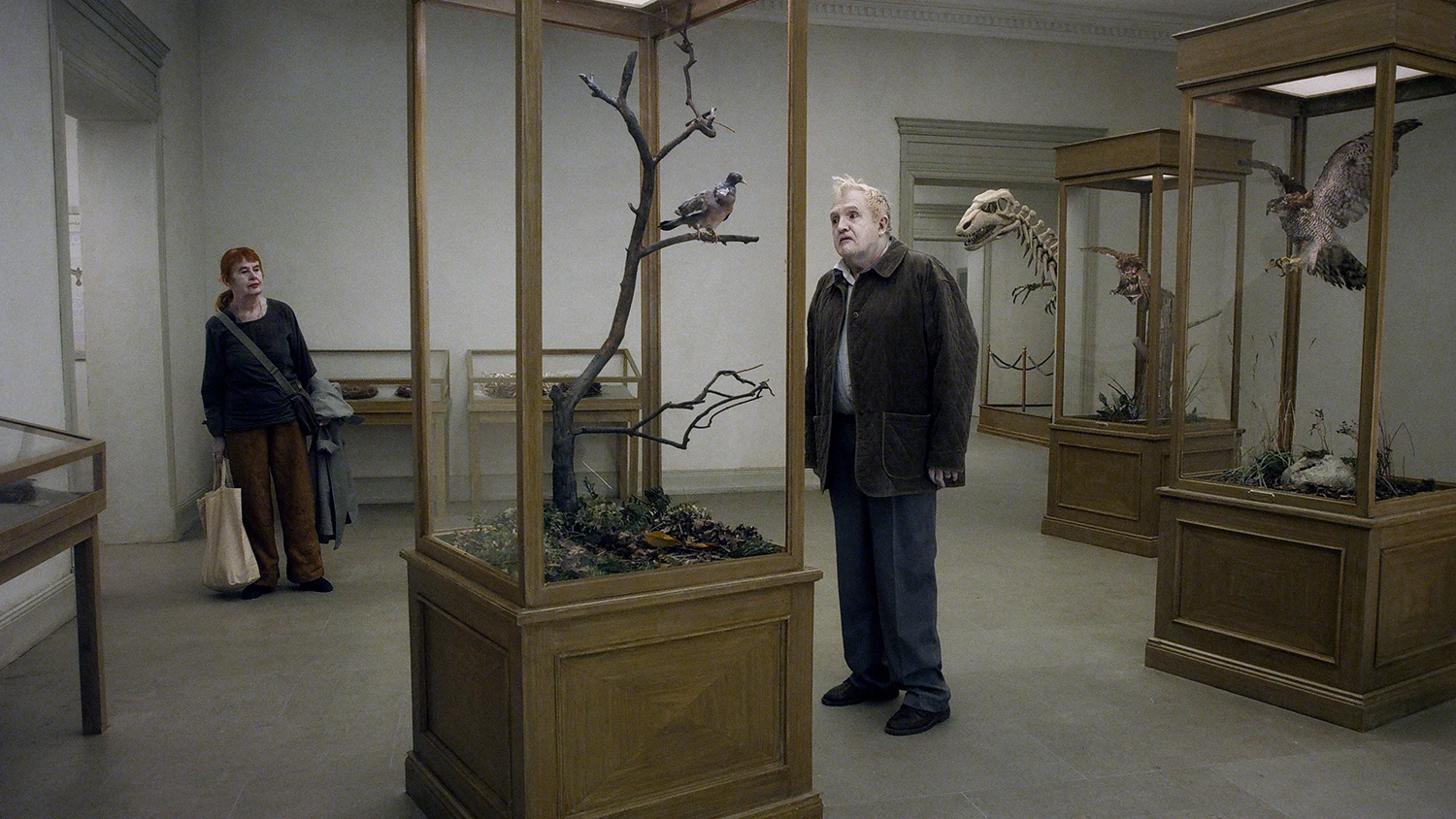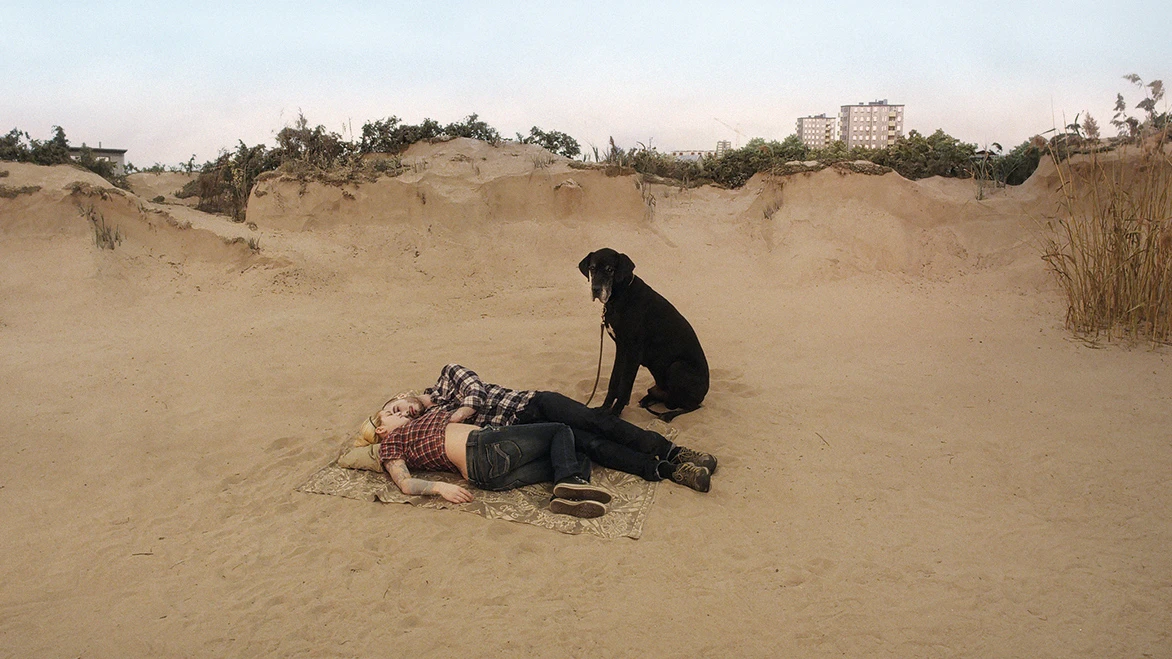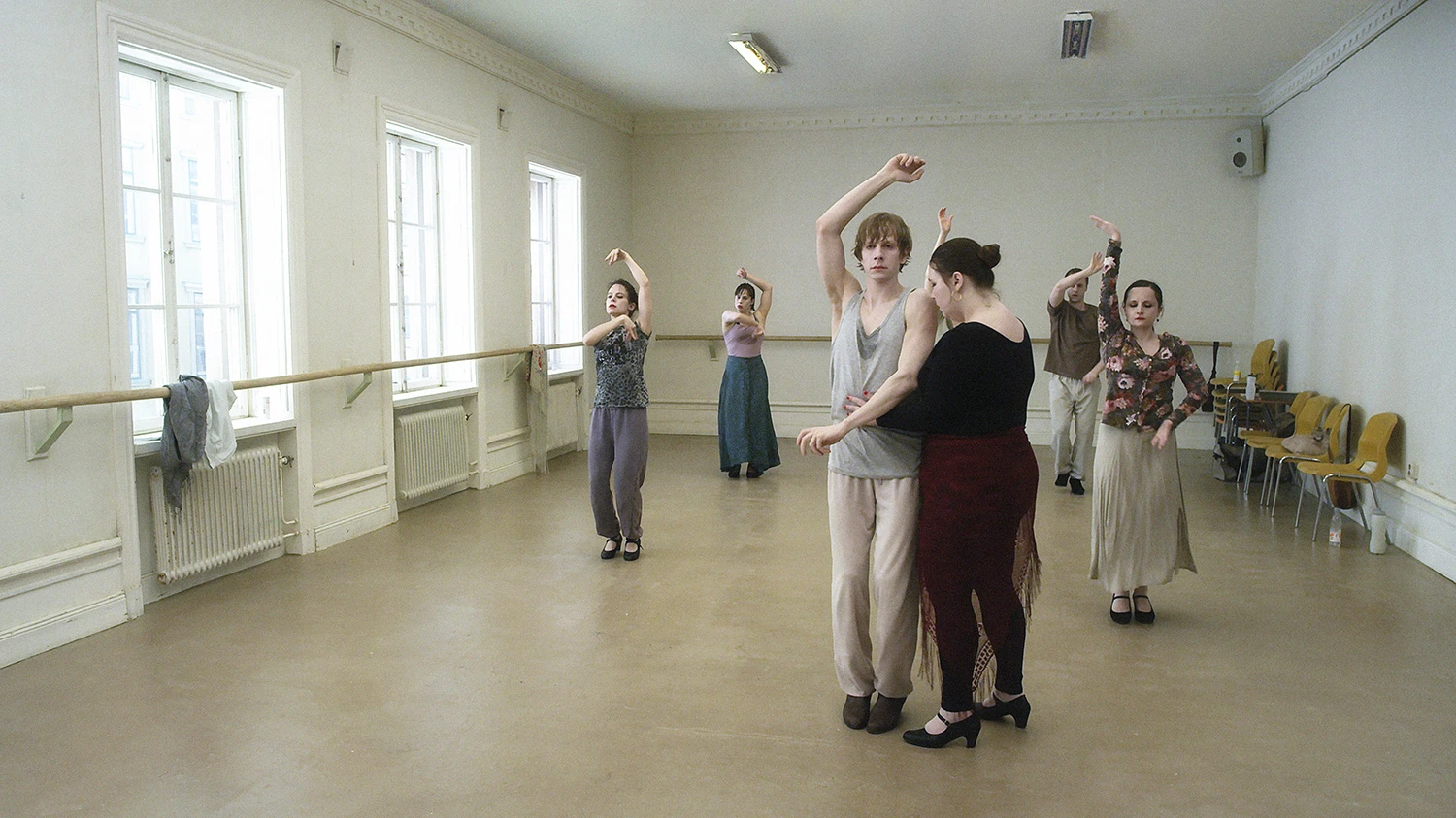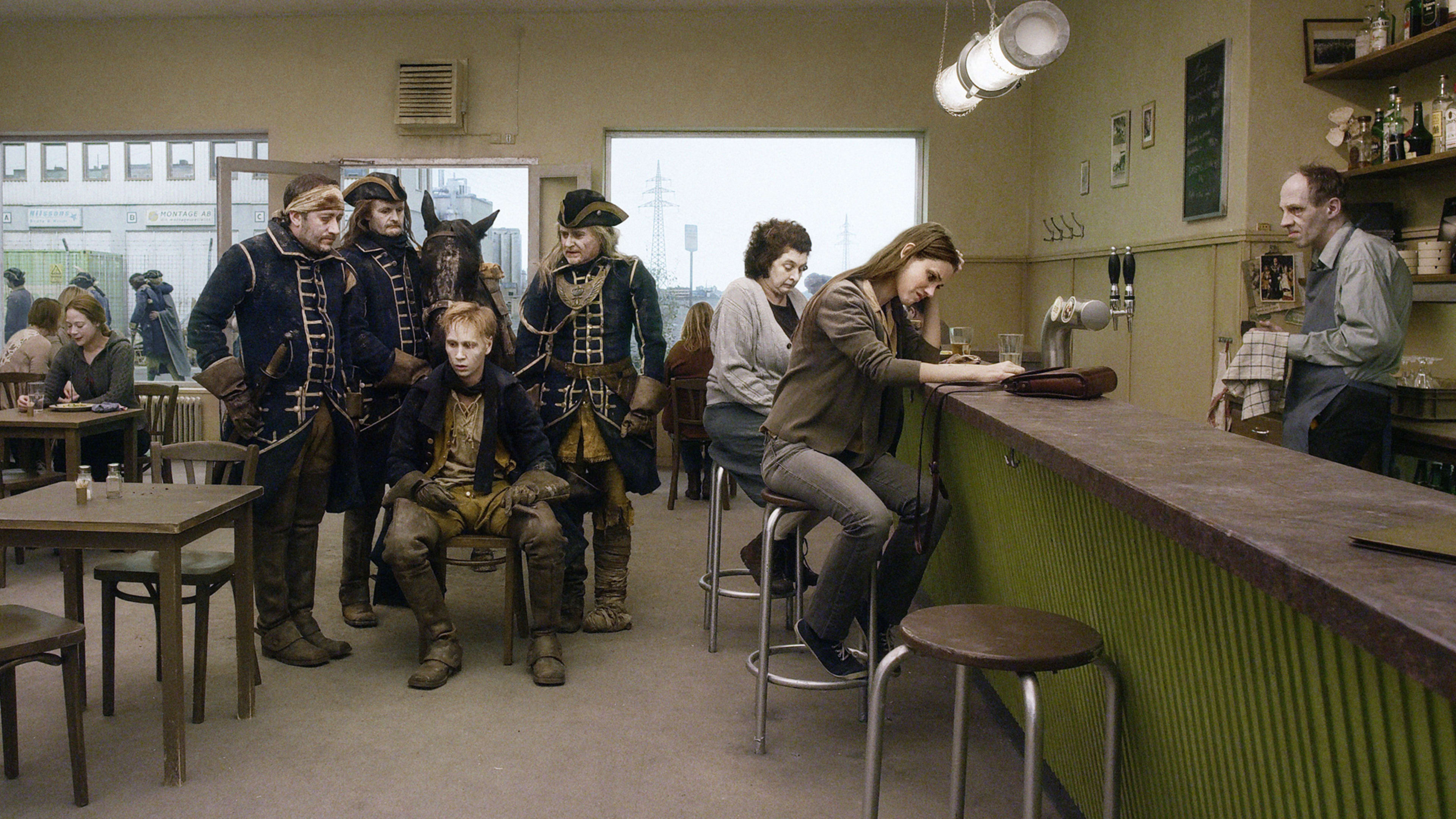You may not know the work of Roy Andersson unless you are a cinephile, but the Swedish director counts filmmakers like Alejandro G. Iñárritu and Darren Aronofsky among his fans. In fact, Iñárritu and Aronofsky are lending their names to the promotion of his latest film, billed as the presenters of A Pigeon Sat on a Branch Reflecting on Existence, which won the Golden Lion at last year’s Venice Film Festival and opens in theaters in New York City on June 3, with a national rollout to follow.
It’s the third in a trilogy of absurdist, almost inexplicable, comedies known as The Living Trilogy, “a trilogy about being a human being.” (In celebration of the completion of this trilogy, which includes Songs from the Second Floor and You, The Living, New York City’s Museum of Arts and Design launched a retrospective called It’s Hard to Be Human: The Cinema of Roy Andersson on May 28.)
Made up of nearly 40 vignettes, many of them focusing on a pair of salesmen selling fake vampire teeth and other novelties, Pigeon is humorous yet tragic. To wit: One of the film’s early scenes finds a man lying motionless on the floor of a cafeteria. When it becomes clear that the man, who had just paid for a beer and some food, has dropped dead, the cashier asks if anyone else would like his meal, still sitting on a tray near the cash register. An awkward silence follows before a fellow patron slowly raises his hand and claims the beer.

Other scenes aren’t funny at all but simply disturbing. In one, a lab monkey is continually shocked while a lab technician casually talks to someone on the phone, constantly saying, “I’m happy to hear you’re doing fine,” a refrain heard in other scenarios, too.
Reflecting Andersson’s signature style, every scene in Pigeon is shot by a camera placed in a fixed position, and on sets that have been painstakingly crafted in the director’s studio. It’s this meticulous technique and attention to detail that explains why the Swedish director has been making movies for 40 years but has only shot five. Andersson’s films, which he writes and finances on his own by shooting commercials, take four years on average to shoot. (It should also be noted that there was a long break–we’re talking 25 years–between his second and third films.)
Co.Create recently rang Andersson at his Studio 24 production company in Stockholm to discuss his influences, his idiosyncratic shooting style, and his reasons for casting mostly non-actors in his films.
Co.Create: Unlike with many of the movies I see, I feel like I could literally draw an accurate picture of so many of the scenes in Pigeon because of the way you keep your camera perfectly still and allow the audience to take in the visuals.

Roy Andersson: I’m so inspired by painting history, and for a long time I’ve been so jealous of painters because they are making scenes, and people can be standing many, many minutes in front of a painting. But it’s so rare in film, in movies, that you have such an interest in movies and look at [a scene] for five, 10 minutes. So my ambition has been to make scenes so clear and so impressive as we can see in painting history.
Many directors talk about other directors and films that have influenced them, but I have read interviews you have done, and you always talk about painters. Are painters the greatest influence on your work?
Yes. Absolutely. But, of course, even the movies, but most of all painting history. It’s a fantastic source we have in our civilization to have the history of painting. I mean, a movie, it is a new thing compared to painting. Movies are 100 years old, and painting is thousands of years old.
What are the inspirations behind Pigeon?
There are some things that are very important here. Above all, the two [novelty salesmen] characters selling these stupid vampire teeth—they are a new version of Stan Laurel and Oliver Hardy. They have inspired me—not now so much but as a child when I grew up. They were both sad and funny at the same time.
I am also inspired by literature—Steinbeck’s Of Mice and Men and Don Quixote and Sancho Panza in the Cervantes novel.
You must have also been inspired by a painter or perhaps a particular painting?
Yeah. Most important for me is the Spanish painter Francisco Goya.

Why Goya?
Look at his paintings. He’s covering all the sides of existence. In some ways, most of the time very poetic, but also very often he describes the cruelty to be a living human.
In modern times, there were two German painters that were so inspiring and so fantastic for me—Otto Dix and also his friend George Grosz. They had experiences in the first World War. When they returned from the war, they could never get rid of these terrible things that they had seen, and you can see that in their paintings.
Do you ever paint, and if so, are you any good at it?
I write scripts, yes, but I combine that with sketches or paintings. So, now, I’m planning to make a new movie, and I start with paintings in watercolor.
So you begin by painting, but when you are writing the script, are you also thinking visually all along the way and making paintings as you go along?
Yeah. When I was young I wanted to be an engineer, first of all, to invent things, to invent the machine of eternity. But when I was around 15, I wanted to be an author to write novels. But when I saw these fantastic movies in the ‘60s, I changed my mind. I wanted to be a film writer. But at the same time, I also wanted to be a musician because I played trombone at that time. So when I decided to make movies, I could combine these three ambitions–visually, literarily, and musically. It’s fantastic.
When you shoot your films, you create these beautifully and carefully constructed sets that take a long time to make. Why do you prefer creating the environment yourself as opposed to going out into the real world and shooting on location?
I really want to have control over the setting because if I don’t have that control, I will be disappointed afterwards. So, for me, I really like that.
You must be an incredibly patient person. For Pigeon, you and your team had to make so many sets, including a beach, a dance studio and a beer hall.
Yes. That’s why it takes four years for me to make the movie.
You have always shot your movies on 35mm film until your latest. Pigeon is the first you have ever shot digitally. Did you enjoy going digital, or did you miss working with film?
During the movie Songs from the Second Floor, I tried to go over to digital technique, but the quality was so bad at that time, so I stopped. But, now, I found four years ago [when I started shooting Pigeon], I saw that it could be as good as analog to make it digitally. And, now, I’m really happy that we’ve made it. I can’t see any reason to go back to the old negative filmmaking. Analog technique is, for me, the stone age now when I look at it.

Like your other movies, Pigeon finds you keeping your camera completely still at a fixed angle. There is no zooming or panning. Have you ever been tempted to move the camera?
If I try to change my style, it gets worse. So I can’t understand why I should change it if it gets worse. You know, there is a story about Charlie Chaplin. He had my style during a long time in his period being in silent movies—fixed camera and so on, and there was just something happening on the stage. And people said to him, “Oh, Charlie, you repeat yourself too much, and can’t you change? Now is the time now you have to change your style.” And he really tried, but it got worse. So he went back to his old style. And that’s what I feel myself.
Is it true that most of the Pigeon cast was made up of people with no acting experience?
Yeah, that’s true. It’s some professionals—I think it’s 20% professionals, and the rest are so-called amateurs. And it’s not that I absolutely hate professionals. No, not at all. But Sweden is a little country. We have around a little above 10 million. And the actors in Sweden, I think there are maybe five thousand, and compared to the rest of the population, you have so much more greater resources out in the country. And my philosophy is also that everybody is an actor and can be an actor. In America, you have Indiana Jones, for example. [Andersson is referring to Harrison Ford.] He was a grip in the beginning of his career. He was a worker, and he’s a fantastic actor. There are many, many examples of that.
You started shooting commercials early on in your career to fund your films. But do you also enjoy shooting commercials? Do you get creative satisfaction out of the experience?
Yeah. I enjoy it because I make it as seriously as I make the feature. So I spend the same interest, the same power, I don’t find the word now, but I care for them similar. I don’t make any difference between commercials and features when I make a scene. I have had help also from the commercials to develop my style, and I do make commercials, but with every commercial I really, really am careful to make commercials with a moral level that I can accept. I don’t make a commercial about things that are not good for us. And I don’t like to make false worldview of how to be lucky in life. I don’t like that kind of commercial.
I have some of them on YouTube—there are some of my commercials. And I will deliver also my collection soon. It’s my 50 or 100 best. I think it’s coming in autumn.
There is so much pressure on directors—at least here in America—to do things a certain way, which often means to do whatever is popular at the time. You have always done things your way. You apparently don’t feel pressured to make films the way other people are making them.
Yes. If I’m not allowed to do it in my way, I lose interest and power. I lose the interest, and I give up. So I have to make it my way.

When you make a film, are you making the film for yourself, or do you think about the audience and make the film for the audience?
I make it for the audience, of course. But I’m also aware there’s a possibility that they won’t like it. But I have to take the risk, and sometimes they’re really pleased at what I do and sometimes not. But in the long run, I think it’s best to make it in my way.
Recognize your brand’s excellence by applying to this year’s Brands That Matter Awards before the final deadline, June 7.
Sign up for Brands That Matter notifications here.
